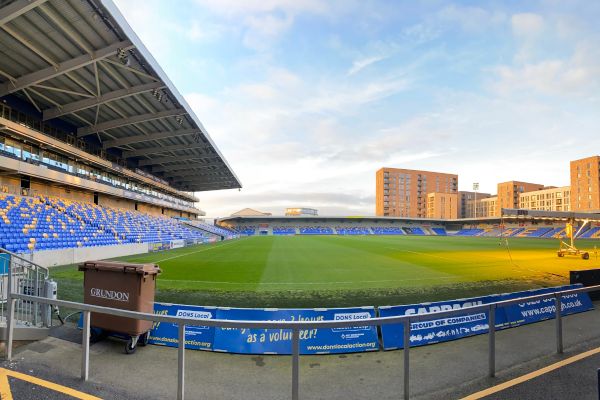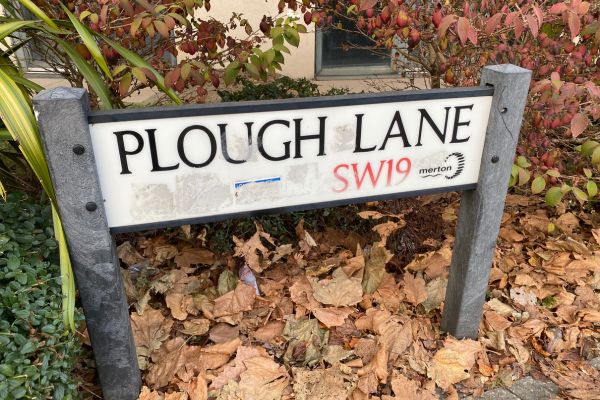A man leans against a lamppost, shoulders slumped with a look of dejection. Around his neck is a worn yellow and blue scarf with faded lettering that can just about be made out, “FA Cup Champions 1988.” Under the brow of his Peaky Blinder-style cloth cap, he looks ahead.
In front of him is what could be mistaken for a bomb site. But it is actually the remains of a demolished stadium. A stadium that once held great memories for this man.
In his mind, he can hear the words, "The Crazy Gang have beaten the Culture Club.” A famous term coined by legendary BBC commentator John Motson, referring to Wimbledon’s shock victory over Liverpool in the 1988 FA Cup Final. The man was thinking back to better days. Days when his team defied all odds to become champions.
The Fall of Wimbledon FC
That was 1988. Now it was May 2002, and the man, a lifelong fan of Wimbledon Football Club, had heard the news that the Football Association had given permission for the new owners of the club to move the team to a new stadium over 100km away in Milton Keynes.
As he pondered the news, he muttered to himself, “No bloody way am I going up there every week.” He had already been making the effort to watch his beloved Dons play at Crystal Palace’s Selhurst Park, a stadium located in South London and closer to home. Wimbledon had little option but to leave their home, Plough Lane Stadium, in 1991, as top-level stadiums were required to be all-seater, and the club’s board had failed to either build a new stadium, or redevelop the old one. But travelling so far each game was just not feasible.
The man had come down to the former site of Wimbledon’s old stadium, Plough Lane, to reminisce about days gone by. Leaning against that lamppost, he watched as big diggers and heavy machinery went about their business, clearing away what remained of the stadium to begin work on building housing blocks. Taking one end of his scarf in his hand, he thought to himself, “I’ve now no team and no stadium!”
The Move to Milton Keynes: A Club Torn Apart
Fast forward to 2021, and the man is sitting in a blue seat, an animated expression on his face. He is still wearing a yellow and blue scarf. But this time, it’s different. The colours are bolder and stronger in tone, and the words “DONS” are very visible at each of the scarf’s ends.
Much like his changes in scarf, the man has also seen many changes over an incredible 20 years. You see, since that day when he had no team to support and no stadium to go to, he has witnessed one of the biggest comebacks in football history.
Just like the man, there were many more fans that were unwilling to travel 100km to see a game week in, week out. Especially now that their beloved Wimbledon had since been renamed MK Dons.
The Birth of AFC Wimbledon: A Fan-Led Rebellion
So, what they did next was legendary and will touch the hearts of every true football fan. They channeled the Crazy Gang spirit of 1988. They organised and created a new club called AFC Wimbledon.
With little money and no stadium, they had to start life in the 9th tier of English football, a level where it’s just one man and his dog watching. From 2002, The Dons pulled off an incredible rise through the divisions, achieving six promotions and eventually reaching as high as League One, just two levels below the Premier League.
But for much of this time, the club was still without a proper stadium to call home. The desire to return to Plough Lane was strong, but the challenge was immense. The stadium was gone, now replaced by housing.
The Journey Back to Plough Lane
Yet, like the 1988 team beating the odds, they pushed on and eventually secured planning permission to build a new Plough Lane stadium, just 200 meters from the original site, on what was once a greyhound racing track.

On 3 November 2020, as the referee blew his whistle to start a match between AFC Wimbledon and Doncaster Rovers, a new Plough Lane and home for Wimbledon FC was born.
Unfortunately, no fans were in attendance due to Covid-19 restrictions. But Wimbledon and their fans had endured a testing 30 years, a little wait longer would not matter.
A New Era at Plough Lane
The man in the blue and yellow scarf rises from his seat at the new Plough Lane, applauding as his team leaves the field after a narrow victory. His eyes twinkle with pride.
He turns to a fellow fan and asks, “You looking forward to the game next week?”
“Who’s it against?” the other fan asks.
“MK Dons,” he replies, pointing to the word "Dons" on his scarf before continuing, "Time to get our 'Dons' back."
The other man chuckles and nods, and they both turn to leave.
A Symbolic Connection to the Past

Walking away from the stadium, he passes the site of the old Plough Lane, where now buildings with names like Bassett House and Lawrie House stand. Names associated with former Wimbledon legends.
As he turns the corner, he passes the lamppost he stood against all those years ago. He reaches out, gives it a quick tap with his fingers, and whispers, “Here’s to an even better 20 years, mate.”
Plough Lane Stadium’s rebirth is one that would have never happened without the determination of the fans behind recreating not only a football club but also a home.

In a sentimental gesture to keep Wimbledon’s FA Cup victory ever-present within the new Plough Lane, club legend Vinnie Jones, who was part of the 1988 winning team, donated his winners' medal to the club. His medal is proudly on display in the stadium, along with other memorabilia related to that famous day.
Stadium Relocations: How Far Is Too Far?
In the history of football stadiums, very few have had the chance to rise from the ashes once destroyed. Some ultra-purists may argue that the stadium should have remained in its original location.
However, others feel that as long as a new stadium is within close proximity to the old site, it will continue to keep alive the community of the area and the fans who flock there. Especially those who value the pubs where they gather for pre-and post-game drinks to discuss all things football.
Other stadiums that have made transitions within very close radius to their old stadiums include Tottenham Hotspur, Arsenal, Benfica, and Athletic Bilbao. Most of which have helped make a smooth transition with little resistance or upset from fans.
But one thing that both purists and non-purists can agree on is this ... moving a club more than 100 kilometers away is pretty much a no-go.
But fans can make a difference, and in some cases, they’ve been the driving force behind a club’s return home. AFC Wimbledon, for example, successfully fought to return to their spiritual home at Plough Lane, after years of battling to preserve their identity and community.
This raises an important question: should fans be allowed to own a stake in the stadiums they call home to ensure history doesn’t repeat itself, as with the case of Wimbledon? A recent example of fans taking control of their stadium is that of St. Pauli, where supporters raised millions to buy shares in their iconic Millerntor-Stadion. You can read more about this groundbreaking move in our article, How Fans Bought St. Pauli’s Stadium.
